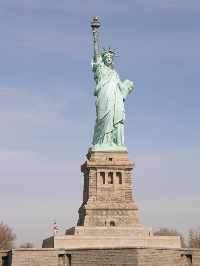The Cloisters
I was particularly keen to get to New York in time to go to the Cloisters in Fort Tyron Park before we returned the car at the Airport and flew out. This is best visited by car. Wendy was very dubious about my enthusiasm but was soon converted, proclaiming the Cloisters one of the best things she had seen during the whole trip. The Cloisters overlook the Hudson River and incorporate medieval cloisters from five French abbeys together with gardens incorporating plants mentioned in medieval manuscripts. They are the gift of John D Rockefeller Jr who also purchased a major collection of medieval art and artefacts that are housed there. The Cloisters provide an amazingly peaceful atmosphere, when there are not too many visitors, complimented occasionally by softly played Gregorian Chants.
They immediately bring home the attraction of medieval Christianity and a monastic lifestyle. It is easy to see how intelligent people in the Middle Ages would find this attractive in a time when all informed people still believed that this Earth was the centre of the universe and all creation was intended by its creator to culminate in humankind, formed in His image.
From this it is a small step to believing in that one is saved from the consequences of falling short of God’s intended design and hopes for us, one’s sins, by the sacrifice of His human son on our behalf. In consequence there was no higher calling than to spend one’s life in praise of the creator for His beneficence; through one’s every living act.
This cosmology may seem silly to day; when we know we are certainly not at the centre of, or the central object of, creation. We now understand that each of us is but one possible arrangement of cells following a structure evolved from our ancestors, in that way similar to all the other animals and living things on the planet; that life probably accidentally infected the earth 3 to 4 billion years ago and it is probable that many other galactic objects are similarly infected; that the earth is an insignificant planet that orbits the sun and our galaxy in an unimaginably vast universe; and that humans have existed in our present form for an infinitesimally brief flash of time, much less than a thousandth of one galactic orbit. One galactic orbit takes approximately 250,000,000 terrestrial years; our galaxy, just one of trillions, has already turned at least 50 times and is expected to go on turning for a lot longer.
Nevertheless there are few places more beautiful; or containing objects as beautiful; or as culturally significant to Europeans; as the Cloisters.
East Coast Photo Gallery
This is an edited gallery of my photographs from the trip - click on the image:
or Click Here

